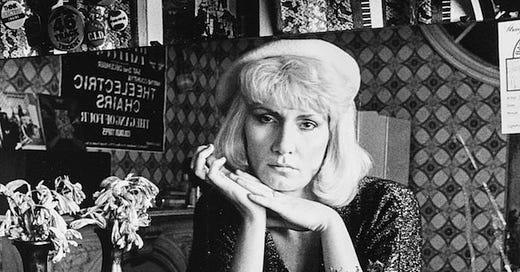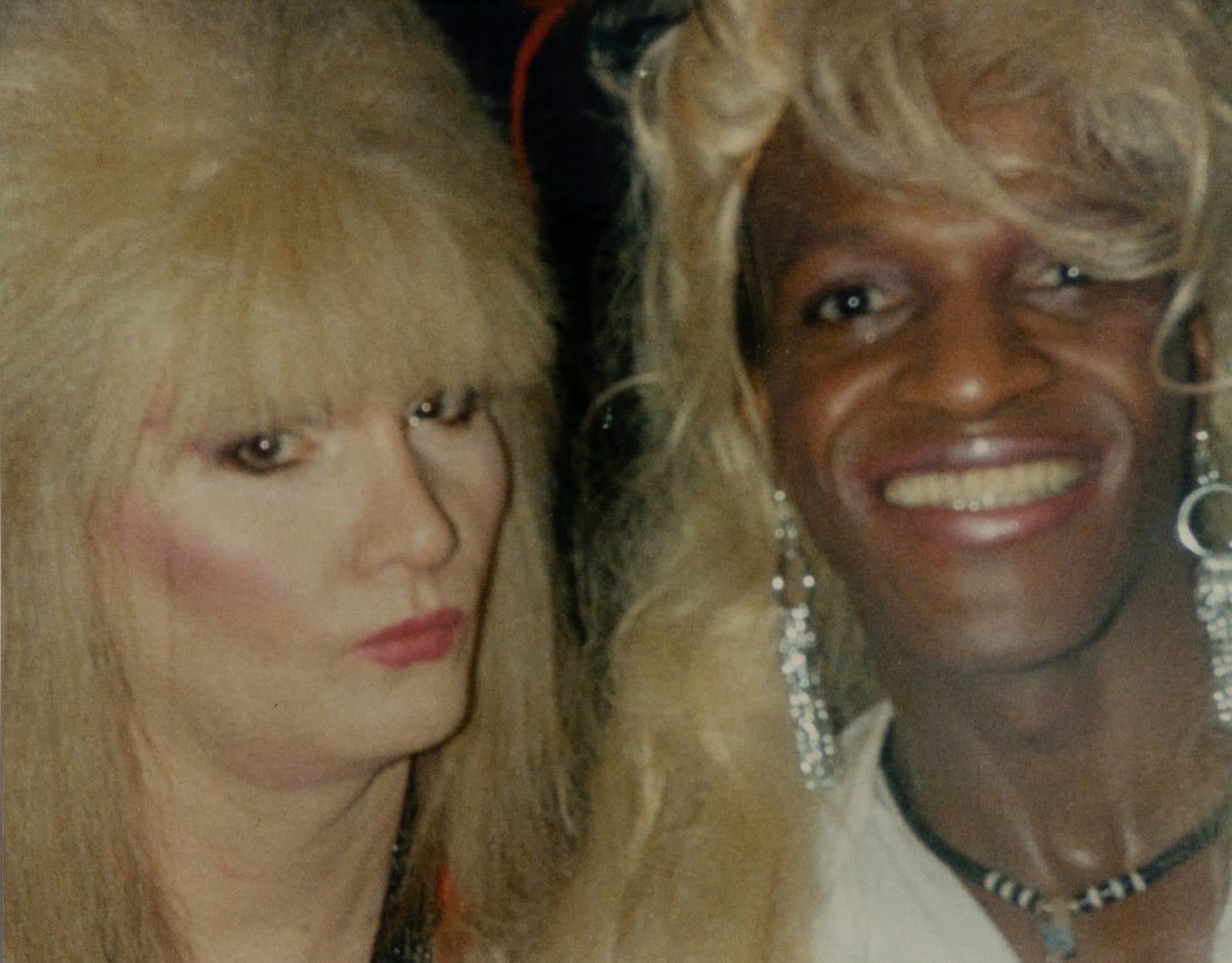Trans Icon Jayne County Was a Template for Glam and Punk Rock. Why Isn’t She a Household Name?
If a person merely existing as trans is subversive, then Jayne County is going to exist the fuck out of this place. Being shot at by locals, fetishized by records companies, and ripped off by David Bowie? It’s all a day’s work for the woman who was the first trans punk icon.
Art rock, glam, and punk are all deeply indebted to trans artists like Jayne County, who helped shatter rigid gender norms, influencing the androgynous and flamboyant aesthetics that became the hallmarks of those genres. The gender-fluid personas that defined David Bowie, Lou Reed, and the New York Dolls were a direct reflection of the trans and queer trailblazers already living those truths in underground spaces.
The punk rock ethos is a notorious symbol for the anti-establishment. But back in the ‘60s, it was called “wrecking,” or at least that’s what County and her crew of “screaming queens” from Atlanta called it.
“We were deliberately trying to freak out the regular people, the solids as we called them,” she told The Guardian in 2021. “Shaking people out of their normality, just trying to see what nerves we could push. They need their nerves twisted once in a while.”
Brandishing a teasing comb with a sharp metal tip for protection, County learned how to survive as a trans woman from her mentor, Miss Cocks.
“We used to do things like go into department stores and ride up and down the elevators just screaming, holding up women’s clothes and saying, ‘Look at this! He’s going to adore me in this!’”
Born in 1947 in rural Georgia, County came of age in the Deep South, where hostility toward queer and trans people was often violently enforced. But County wasn’t the type to shrink in the face of oppression.
“One of our big wrecks was going into the men’s room at the Greyhound bus station, a bunch of us queens, maybe four or five,” County said. “The men were at the urinals with their you-know-whats out and we’d start screaming, ‘Ooh, look how big it is! Look at that one! Oh my God, I think I had that one last night! How is your wife in bed, darling? I’d be a lot better!’ The guys would be rushing to get their zippers up, so uncomfortable with us in there. It’s a wonder we didn’t get killed. We did get shot at. They would actually come by in their trucks and shoot at us. You could hear the bullets flying past your head.”
County started dressing in drag and sneaking out of the house at 16 years old. At 21, she moved to New York City with 20 bucks to her name. Her first drag performances were miming to queer artists like Dusty Springfield and Janis Joplin. She became a fixture at the Stonewall Inn. And during the infamous police raids that ignited the LGBT civil rights movement, County took to the streets alongside Marsha P. Johnson and other trans activists.
County was among the luminaries like Jackie Curtis, Candy Darling, and Holly Woodlawn who were part of the avant-garde New York scene where glam rock and punk gestated. Their defiance and self-expression helped establish the ethos of these scenes: rejecting societal norms and celebrating individuality.
It’s no wonder she ended up on stage. County appeared in her first play, “Femme Fatale,” in 1969. Co-starring with punk godmother, Patti Smith, County got cast as a psychotic lesbian prisoner. The show was written by her friend and roommate, Jackie Curtis— the eventual Lou Reed muse from “Walk on the Wild Side.” The play’s success, as well as her constant presence as resident DJ at Max’s Kansas City (the unofficial headquarters of the New York underground) catapulted her into the underground theater scene and attracted the attention of Andy Warhol.
The artist cast County in his first stage show, “Pork,” a self-referential commercial success that delighted and enraged audiences in New York and then London in 1971.
In 1974, County formed Wayne County and the Backstreet Boys, which recorded three tracks for the compilation album, Max's Kansas City: New York New Wave. In 1976, she appeared in the seminal film, The Blank Generation, which documented and helped define the beginnings of the punk genre.
All of that happened and yet, a recurring theme throughout County’s life was the way she inspired unapologetic disruptions of cultural norms without acknowledgement of her contributions. The glam and punk movements borrowed the aesthetics, gender experimentation, and confrontational attitude of trans and queer performers. But trans artists are the unsung pioneers of these cultural revolutions.
County cites her relationship with David Bowie as a prime example. Bowie’s manager added County’s first band, Queen Elizabeth, to the label as part of a marketing effort to make Bowie seem “shocking.” Bowie was planning his reinvention as Ziggy Stardust—who surely admired County’s fashion choices and onstage antics. To this day, County maintains that Bowie’s “Rebel Rebel” was inspired by — or maybe ripped off from — her song “Queenage Baby.”
But Bowie wasn’t the only figure in rock & roll to bask in County’s example. Lou Reed’s album, Transformer, became a cornerstone of glam rock and drew significant influence from queer culture and the trans people he encountered at Max’s Kansas City and Warhol’s Factory. At least he acknowledges as much in his iconic song, “Walk on the Wild Side,” which name checks trans and genderqueer performers like Holly Woodlawn, Candy Darling, and Jackie Curtis—all contemporaries of County in the downtown art scene.
Then there’s Marc Bell, eventually known as Marky Ramone of The Ramones. He began his career playing drums in County’s band. Among the first big breaks for The Police was opening for County in 1977. Composer and television personality Jools Holland began his career as a session musician. His first gig was on County’s 1976 track, “Fuck Off.”
While these cisgender artists found mainstream success, the trans individuals who inspired them were left out of the spotlight—or exploited as countercultural “muses” rather than credited as creators. County’s music, such as “Fuck Off” and “Man Enough To Be a Woman,” captured the frustration, anger, and resilience of being marginalized in a society hostile to her existence.
I got a transexual feeling
It’s hard to be true to the one that’s really you
I got a scandalous feeling
It’s hard to be true when they point and stare at you
Conditioned to portraying the mask of masculinity
Another blend of different shading
I am what I am
I don’t give a damnI wanna know, I wanna know
I wanna know, I wanna know…
I wanna know, I wanna know
Are you man enough to be a…woman?
Frustrated by being too “obscene” for American record labels, County moved in 1977 to London where the British punk scene was emerging and welcomed her brash onstage persona with open arms. Her band, Wayne County & the Electric Chairs, released Electric Chairs 1977 on Illegal Records. And County met queer filmmaker Derek Jarman, who cast her as Lounge Lizard in the seminal punk film Jubilee. County was also featured in The Punk Rock Movie by Don Letts.
So if Jayne County was featured in every film about the burgeoning punk scene and her style was copied by the likes of Bowie, Reed, and the New York Dolls, why isn’t she a household name?
It’s unfair. But erasure is part of a larger pattern of marginalization that ought to be familiar. Trans stories are invisible even within queer histories. Figures like Jayne County were dismissed as too “extreme” for the mainstream, even as their ideas and essence were co-opted.
We don’t have to let it continue. Trans artists brought conversations about gender and sexuality to the forefront of countercultural movements. In an era when even discussing these topics was taboo, they dared to live authentically, forcing audiences to confront questions of identity, authenticity, and liberation. By understanding the role of trans artists in shaping glam and punk, we not only honor their contributions but also reclaim a history that has been stolen, distorted, or forgotten.
It’s not just that glam and punk are indebted to trans artists like Jayne County—it’s that without them, these movements might not have existed in the way we know them today.
Support my work by upgrading to a paid subscription or pay what you wish for this article.







Thank you thank you thank
you for the County intro. I’m putting her at the top of my playlist for discovery! And you do her justice. You should write her biography.
What an absolute badass